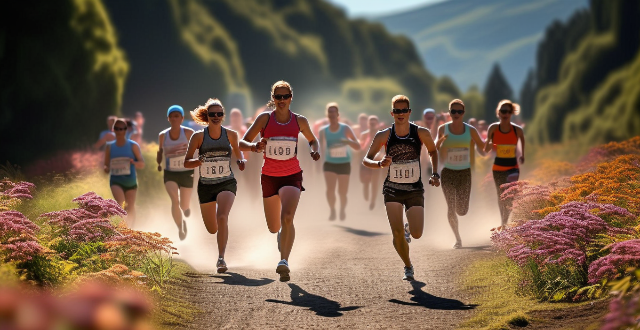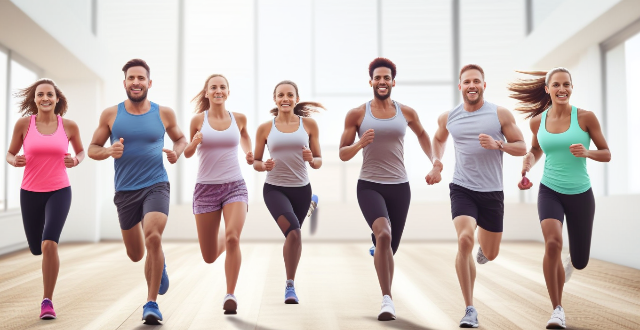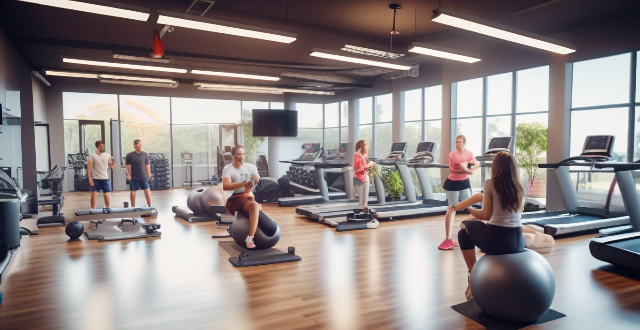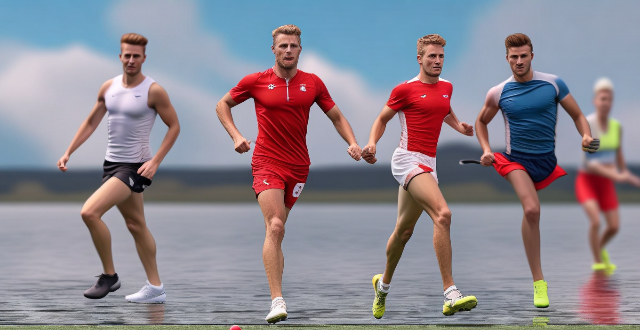Race Pace

How can I maintain proper pacing during a race or long run ?
Maintaining proper pacing is crucial for achieving your best performance in a race or long run. To do this, set a realistic goal time based on your training and past performances. Start the race at a slower pace than your goal pace to warm up your muscles and avoid starting too fast. Use a running watch or app to track your pace and distance during the race, and focus on your breathing to maintain a steady rhythm. Stay hydrated by drinking water or sports drinks regularly, and adjust your pace as needed if you feel like you're running too fast or too slow. Practice pacing in training so that it becomes second nature during races. By following these tips, you can achieve your best performance while listening to your body and adjusting your pace as needed.

What is the ideal pace for a beginner in a marathon ?
When it comes to running a marathon, the ideal pace for beginners is an important factor to consider. It is crucial to find a balance between pushing yourself and avoiding burnout or injury. Here are some tips on determining the ideal pace for beginners in a marathon: 1. Start with a realistic goal 2. Use a training plan 3. Practice pacing during training runs 4. Consider your individual factors 5. Use online calculators and resources 6. Don't forget about recovery

Is it beneficial to match the tempo of music with the pace of your exercise ?
Exercising is an essential part of a healthy lifestyle, and many people enjoy listening to music while working out. The tempo of music can have a significant impact on your exercise routine, and it is important to consider whether matching the tempo of music with the pace of your exercise is beneficial. Benefits of matching tempo and pace include improved performance, increased motivation and enjoyment, and distraction from fatigue. However, drawbacks such as overexertion and distraction from proper form should also be considered. Ultimately, whether or not to match the tempo of music with the pace of your exercise will depend on your individual preferences and goals.

What kind of training do I need to participate in a marathon or trail run ?
To participate in a marathon or trail run, it is essential to have a comprehensive training plan that focuses on endurance, strength, speed, and recovery. This includes gradually increasing the distance of long runs, incorporating tempo runs and hill repeats for endurance, core workouts and lower body exercises for strength, interval training and fartlek for speed, as well as prioritizing adequate sleep and nutrition for recovery. Mental preparation techniques like visualization and goal setting can also be beneficial. On race day, pacing strategies, equipment checks, and a detailed race plan are crucial for success.

How do I prevent injuries during marathon training ?
Preventing injuries during marathon training is crucial for a successful and enjoyable race. To reduce the risk of injury, runners should warm up and cool down properly, gradually increase training intensity, incorporate cross-training, wear proper footwear, stay hydrated and well-nourished, schedule rest days, listen to their bodies, engage in strength training and flexibility work, and prepare for race day with pacing strategies and course familiarization. By following these guidelines, runners can minimize the chances of getting injured and maximize their potential for success on race day.

What are the best training methods for a marathon ?
The article provides a summary of the best training methods for a marathon, including long runs, interval training, hill training, tempo runs, cross-training, recovery weeks, race pace workouts, and tapering. It emphasizes the importance of consistency, patience, and listening to one's body during training.

What are some examples of successful sports charity events ?
Successful sports charity events like the Nike Foundation's "Girl Effect" Marathon, The Komen Race for the Cure, and The Wounded Warrior Project's Carry Forward 5K have raised millions of dollars for various causes by combining the excitement of sports with philanthropy. These events engage participants in physical activity, raise funds and awareness for important causes, and create a sense of community among participants and supporters.

What are the benefits of participating in adventure races ?
Adventure races offer numerous benefits including improved cardiovascular fitness, muscular strength, weight management, stress reduction, enhanced cognitive function, emotional well-being, adventure and fun, personal growth, community involvement, and more. These multi-discipline events challenge participants physically and mentally while promoting overall health and wellness. Whether seeking a thrilling experience, personal development, or simply enjoying nature, adventure races provide an excellent way to achieve these goals while having fun and creating lasting memories.

Can developed and developing countries achieve carbon neutrality at the same pace ?
The article discusses the challenges and potential solutions for developing countries to achieve carbon neutrality at the same pace as developed countries. The key differences between developed and developing countries in terms of economic development, technological advancements, and political will are highlighted. Developed countries have higher GDP per capita, more resources for research and development, and greater financial capacity to invest in renewable energy infrastructure. In contrast, developing countries have lower GDP per capita, limited resources for research and development, and less financial capacity to invest in renewable energy infrastructure. Technological advancements also play a crucial role in achieving carbon neutrality. Developed countries have advanced technology and innovation in clean energy sectors, access to cutting-edge research facilities, and well-established industries with experience in implementing sustainable practices. In contrast, developing countries have emerging technology and innovation in clean energy sectors, limited access to advanced research facilities, and infant industries with less experience in implementing sustainable practices. Political will is another factor that affects the pace of achieving carbon neutrality. Developed countries have stronger political commitment to addressing climate change through policy measures, more established regulatory frameworks for promoting renewable energy adoption, and greater public awareness and support for environmental issues. In contrast, developing countries have varying levels of political commitment to addressing climate change through policy measures, less established regulatory frameworks for promoting renewable energy adoption, and lower public awareness and support for environmental issues due to other pressing concerns such as poverty and healthcare. Developing countries face several challenges in achieving carbon neutrality, including lack of financial resources, technological barriers, and infrastructure challenges. Potential solutions for developing countries include international cooperation and funding, capacity building and education, and policy interventions and regulatory reforms. By working together through these solutions, both developed and developing countries can make significant progress towards a more sustainable future.

What are the most common metrics used in analyzing sports performance ?
Analyzing sports performance is crucial for athletes, coaches, and teams to improve their skills, strategies, and overall performance. There are several metrics used to evaluate different aspects of sports performance, including time-based metrics such as speed and pace; distance-based metrics such as distance covered and displacement; power-based metrics such as peak power and power endurance; technique-based metrics such as form analysis and biomechanical analysis; physiological metrics such as heart rate and VO2 max; and mental metrics such as mental toughness and motivation levels. These metrics can help athletes and coaches identify areas for improvement and develop effective training programs to enhance performance.

What are the best fitness apps for tracking workouts and monitoring progress ?
The text discusses the best fitness apps for tracking workouts and monitoring progress, including: 1. **MyFitnessPal** - Calorie tracker with goal setting and community support. 2. **Strava** - GPS tracking for outdoor workouts with leaderboards and route planning. 3. **Nike Training Club** - Offers workout plans with video tutorials and a variety of exercises. 4. **Fitbit** - Activity tracker syncing data from Fitbit devices with goal setting and food logging. 5. **7 Minute Workout** - Quick high-intensity workouts that can be done without equipment. 6. **Couch to 5K (C25K)** - Beginner-friendly app for starting a running routine with motivational coaches. 7. **Yoga Studio** - Wide variety of yoga classes with customizable and audio options. 8. **Sworkit** - Customizable bodyweight exercise routines with a variety of workouts. 9. **Freeletics** - AI coaching for personalized workout plans and nutrition guidance. 10. **Adidas Runtastic** - GPS tracking with training plans and health metrics.

Are there any events or clubs that organize group cycling trips on specific routes ?
There are many events and clubs that organize group cycling trips on specific routes, providing opportunities for cyclists to explore new places, meet other riders, and enjoy shared experiences. Examples include the Gran Fondo World Championships, Tour de Cure, RAAM, local cycling clubs, bike shops, and online communities like Strava, Facebook, and Meetup. These organizations offer a range of rides and races, from beginner to advanced levels, and cater to different interests such as road biking, mountain biking, and fundraising.

What are some famous examples of sports-inspired art ?
Sports have been a significant source of inspiration for artists, resulting in various forms of art that capture the essence of athleticism and competition. Notable examples include Rubens' "The Chariot Race," Degas' "Olympia" series, Neiman's painting of the Muhammad Ali vs. George Foreman match, Sennwald's photographic series on Wilt Chamberlain, Banksy's Tour de France-inspired graffiti, Goya's "The Boxer," Darnell's oil paintings of Michael Jordan, Orzechowski's watercolors of female Olympians, Djordjevic's abstract sculpture of speed skaters, and Botero's soccer player sculptures and paintings. These works showcase the dynamic nature of sports and the human spirit through various artistic styles and mediums.

What role does creativity play in sports performance ?
Creativity plays a significant role in sports performance, enhancing problem-solving abilities, improving decision-making skills, and fostering mental toughness. Athletes who are creative thinkers can come up with innovative solutions to challenges, make split-second decisions that impact game outcomes, and stay focused under pressure. Moreover, creativity contributes to the development of new techniques and styles within sports, pushing boundaries and evolving the sport itself. By harnessing their creative potential, athletes can elevate their performance and achieve greater success.

What are some popular books discussed in celebrity book clubs ?
The text provides a list of eight books that have been popular in celebrity book clubs. Each book is summarized, including its author, genre, and a brief summary of its content. The books cover a range of topics, from personal memoirs to historical fiction, and explore themes such as identity, race, family, education, and resilience.

What role does mental preparation play in improving running performance ?
Mental preparation is key to improving running performance. It involves setting clear goals, using visualization techniques, practicing mindfulness exercises, and employing self-talk strategies. By training the mind to focus on the task at hand, manage stress, and maintain motivation, runners can enhance their physical performance and achieve their running goals.

What is the latest update on the NBA trade deadline ?
The NBA trade deadline has passed, resulting in severalThe NBA trade deadline has passed, resulting in several impact the league's play resulting in several notable trades that could impact the league's playoff race and future team dynamics. Key trades include the Boston Celtics acquiring Evan Fournier, the San Antonio Spurs sending LaMarcus Aldridge to the Brooklyn Nets, the Golden State Warriors acquiring Andrew Wiggins and D'Angelo Russell, and the Miami Heat acquiring Andre Iguodala. These moves have implications for both the teams involved and the league as a whole, with potential shifts in power and long-term effects on player development and team rebuilding efforts. Fan reactions to these trades have been mixed, with excitement and disappointment among different fan bases.

Can you explain the concept of intersectionality as it relates to women's rights ?
Intersectionality is a term used to describe the interconnectedness of various forms of oppression and discrimination, including race, gender, sexuality, class, ability, and other factors. It recognizes that individuals can experience multiple forms of discrimination simultaneously, and acknowledges that not all women have the same experiences or face the same challenges. Intersectionality advocates for an approach that takes into account all aspects of a person's identity and experiences, recognizing and addressing the ways in which different forms of discrimination overlap and intersect. This concept is important for understanding and addressing women's rights because it recognizes the diversity of women's experiences and the need for a nuanced approach to advocacy and policy-making.

What are the benefits of interval training for runners ?
Interval training is a method of exercise that involves alternating periods of high-intensity activity with periods of low-intensity activity or rest. For runners, this means alternating between running at a fast pace and jogging or walking. Here are some benefits of interval training for runners: 1. Improved Cardiovascular Fitness: Interval training can help improve cardiovascular fitness by increasing the heart rate and breathing rate during the high-intensity intervals. This can lead to improved endurance and stamina, allowing runners to run longer distances without getting tired as quickly. 2. Fat Loss: Interval training is an effective way to burn fat and lose weight. The high-intensity intervals cause the body to burn more calories than steady-state cardio exercises like jogging or running at a consistent pace. This can lead to faster weight loss and a leaner physique. 3. Increased Speed and Power: Interval training can also help increase speed and power in runners. By pushing the body to its limits during the high-intensity intervals, runners can improve their muscle strength and power, which can lead to faster running times and better performance in races. 4. Time Efficiency: Interval training is a time-efficient way to train for runners. Because it involves short bursts of high-intensity activity, it can be done in less time than traditional steady-state cardio exercises like jogging or running at a consistent pace. This makes it an ideal workout for busy athletes who want to maximize their time spent exercising. 5. Reduced Risk of Injury: By incorporating periods of low-intensity activity or rest into their workout routine, runners can reduce their risk of injury from overuse or repetitive strain injuries. This is because interval training allows the body to recover between high-intensity intervals, reducing the stress on joints and muscles.

What role does music play in team sports and group fitness classes ?
Music plays a crucial role in team sports and group fitness classes by motivating participants, setting the pace, enhancing enjoyment, fostering social interaction, improving mental toughness, and aiding recovery. It is used across various settings like yoga, cycling, basketball, and team-building activities to create a specific atmosphere or achieve a desired effect.

What is the definition of equitable vaccination distribution ?
Equitable vaccination distribution is the fair and just allocation of vaccines to all individuals, regardless of their socioeconomic status, race, ethnicity, or geographic location. It ensures that everyone has equal access to vaccines and can receive them in a timely manner. Key principles include fairness, transparency, solidarity, accountability, efficiency, respect for human rights, and scientific evidence-based decision making. Examples of equitable practices include prioritizing high-risk groups, addressing geographical disparities, promoting diversity and inclusion, and collaborating with international organizations. Equitable distribution is crucial for achieving herd immunity and ending the pandemic, protecting vulnerable populations, reducing health disparities, and saving lives.

Can fitness trackers be used for swimming ?
Fitness trackers can be used for swimming, but they must be waterproof or swim-proof. Look for features such as heart rate monitoring, stroke analysis, distance and pace tracking, GPS, and long battery life. Make sure to wear the tracker properly, rinse it after each use, charge it regularly, and sync your data to track your progress.

What are some adaptive sports for people with physical disabilities ?
Adaptive sports are modified or specially designed physical activities for people with disabilities, promoting fitness, health, and inclusion. They offer opportunities for competition and social interaction. Popular adaptive sports include wheelchair basketball, racing, and tennis; sitting volleyball; para swimming; track and field events for amputees; goalball; para alpine skiing; and beep baseball for the visually impaired. These sports provide physical benefits and opportunities for personal growth, independence, and social integration.

How can we ensure equitable access to healthcare during pandemic management ?
The article emphasizes the significance of equitable healthcare access during pandemics like COVID-19. It outlines various strategies to achieve this goal, including implementing universal health coverage, utilizing community health workers, expanding telehealth services, managing supply chains efficiently, conducting public education campaigns, providing financial support to vulnerable groups, and fostering collaborative partnerships. These measures aim to ensure that everyone has equal opportunities to receive medical care, regardless of their socio-economic status, race, ethnicity, or geographic location.

How do different types of sports sponsorship (e.g. title sponsorship, kit sponsorship) affect a company's brand exposure ?
This text discusses various types of sports sponsorship, including title sponsorship, kit sponsorship, venue sponsorship, event sponsorship, and team sponsorship. Each type offers different impacts on brand exposure, such as high visibility, brand association, targeted audience reach, community involvement, and potential for success sharing. Overall, sports sponsorship provides companies with opportunities to align themselves with the excitement and passion of sports, reaching diverse audiences and enhancing their brand image.

How significant is the role of luck or chance in determining success at high-level sports competitions ?
Luck or chance can play a significant role in determining success at high-level sports competitions. Factors such as injuries, weather conditions, equipment malfunctions, referee decisions, and opponent's mistakes can all contribute to an unexpected outcome. However, skill, training, and strategy are still the most critical factors in determining success in sports.

How do international trade agreements influence environmental policies and sustainability efforts ?
International trade agreements significantly influence environmental policies and sustainability efforts through harmonization of standards, potential for environmental dumping, promotion of green trade practices, and challenges in balancing trade liberalization with environmental protection. These agreements can either elevate global environmental standards or lead to a race to the bottom in regulatory protections. Policymakers must navigate the complexities of these agreements to ensure they support sustainable development goals without undermining environmental commitments.

What policies can governments implement to promote educational equity ?
Policies for Promoting Educational Equity summarizes key policies governments can adopt to ensure equal access to quality education for all students, regardless of their socio-economic background, race, gender, or any other factors. These policies include universal access to education, quality education, inclusive education, reducing socio-economic disparities, promoting gender equality, addressing racial and ethnic disparities, and collaboration and partnerships with non-profit organizations, private sector companies, and community groups.

Are there any negative impacts of listening to music while exercising ?
Listening to music while exercising can have both positive and negative effects. Some potential drawbacks include distraction, reduced awareness of surroundings, hearing damage, discomfort, pacing issues, disruption of natural rhythm, isolation, and lack of feedback. By being mindful of these factors, you can minimize the negative impacts and maximize the enjoyment and effectiveness of your workouts.